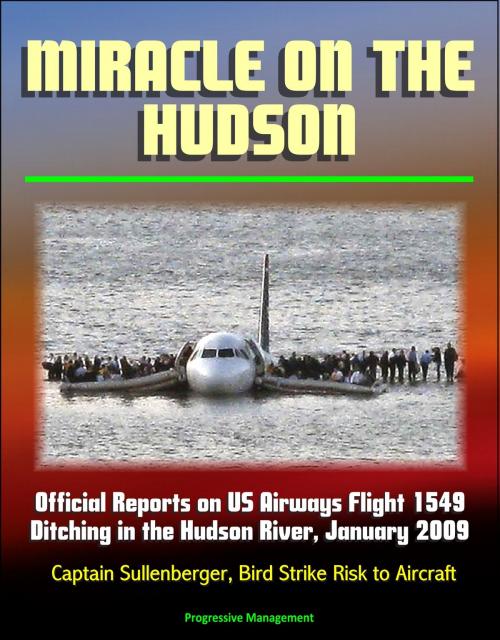Miracle on the Hudson: Official Reports on US Airways Flight 1549 Ditching in the Hudson River, January 2009, Captain Sullenberger, Bird Strike Risk to Aircraft
Nonfiction, Reference & Language, Transportation, Aviation, Commercial, Science & Nature, Technology, Aeronautics & Astronautics| Author: | Progressive Management | ISBN: | 9781310694882 |
| Publisher: | Progressive Management | Publication: | January 17, 2014 |
| Imprint: | Smashwords Edition | Language: | English |
| Author: | Progressive Management |
| ISBN: | 9781310694882 |
| Publisher: | Progressive Management |
| Publication: | January 17, 2014 |
| Imprint: | Smashwords Edition |
| Language: | English |
The complete story of the amazing flight of US Airways 1549 is contained in this reproduction of the official National Transportation Safety Board (NTSB) report on the incident, along with the transcript of a hearing before a House of Representatives committee. In addition to coverage of the ditching, there is extensive information about the risk of bird strikes and efforts to mitigate the threat.
On January 15, 2009, US Airways Flight 1549 ditched into the Hudson River at approximately 3:30 p.m. following a double-engine failure while en route to Charlotte Douglas International Airport There were 150 passengers onboard the Airbus A-320 (N106US). Approximately 90 seconds after Flight 1549 departed LaGuardia International Airport ("LGA"), Captain Sullenberger reportedly experienced a double-bird strike on both CFM56-5B/P engines at approximately 2,700 feet above sea level, causing loss of thrust and power in both engines. During this time, Captain Sullenberger communicated with Air Traffic Control Specialist, Patrick Harten, at the New York TRACON LaGuardia Departure Facility regarding the status of Flight 1549. Captain Sullenberger reported that following the bird strike he took control of the aircraft from First Officer Skiles. Captain Sullenberger conferred with air traffic control ("ATC") to ascertain immediate landing sites. The first option contemplated was to return back to LGA; the second was to land at Teterboro Airport in New Jersey. Mr, Harten communicated with 14 entities, including other aircraft in the vicinity and controllers at other ATC facilities to hold aircraft and to assist Flight 1549 in landing. Meanwhile, the pilots ran through their dual-engine failure checklist. They attempted to restart the engines and regain power in the aircraft, but the engines did not restart.
When it became apparent that they would have to ditch the aircraft, Captain Sullenberger announced to the flight attendants and passengers that they should brace for impact. Passengers reported that after this announcement was made, the flight attendants began to shout instructions to passengers in unison - "heads down, stay down." The pilots then landed the aircraft smoothly in the Hudson River. From there, reports from passengers and crew indicate that the evacuation was fairly orderly. Passengers filed out onto the aircraft wings and into the raft slides on both the right and left front of the aircraft. Within minutes after the water landing, ferry boats, police boats, and the U.S. Coast Guard rescued all 155 people. Four were injured, including Flight Attendant Welsh.
The complete story of the amazing flight of US Airways 1549 is contained in this reproduction of the official National Transportation Safety Board (NTSB) report on the incident, along with the transcript of a hearing before a House of Representatives committee. In addition to coverage of the ditching, there is extensive information about the risk of bird strikes and efforts to mitigate the threat.
On January 15, 2009, US Airways Flight 1549 ditched into the Hudson River at approximately 3:30 p.m. following a double-engine failure while en route to Charlotte Douglas International Airport There were 150 passengers onboard the Airbus A-320 (N106US). Approximately 90 seconds after Flight 1549 departed LaGuardia International Airport ("LGA"), Captain Sullenberger reportedly experienced a double-bird strike on both CFM56-5B/P engines at approximately 2,700 feet above sea level, causing loss of thrust and power in both engines. During this time, Captain Sullenberger communicated with Air Traffic Control Specialist, Patrick Harten, at the New York TRACON LaGuardia Departure Facility regarding the status of Flight 1549. Captain Sullenberger reported that following the bird strike he took control of the aircraft from First Officer Skiles. Captain Sullenberger conferred with air traffic control ("ATC") to ascertain immediate landing sites. The first option contemplated was to return back to LGA; the second was to land at Teterboro Airport in New Jersey. Mr, Harten communicated with 14 entities, including other aircraft in the vicinity and controllers at other ATC facilities to hold aircraft and to assist Flight 1549 in landing. Meanwhile, the pilots ran through their dual-engine failure checklist. They attempted to restart the engines and regain power in the aircraft, but the engines did not restart.
When it became apparent that they would have to ditch the aircraft, Captain Sullenberger announced to the flight attendants and passengers that they should brace for impact. Passengers reported that after this announcement was made, the flight attendants began to shout instructions to passengers in unison - "heads down, stay down." The pilots then landed the aircraft smoothly in the Hudson River. From there, reports from passengers and crew indicate that the evacuation was fairly orderly. Passengers filed out onto the aircraft wings and into the raft slides on both the right and left front of the aircraft. Within minutes after the water landing, ferry boats, police boats, and the U.S. Coast Guard rescued all 155 people. Four were injured, including Flight Attendant Welsh.















